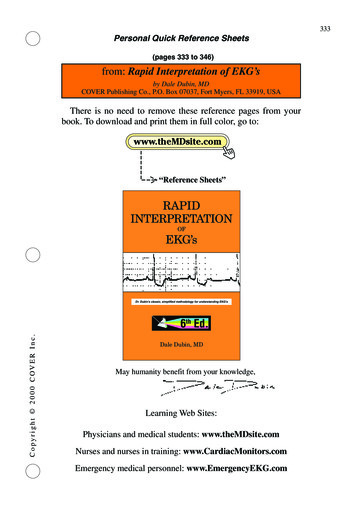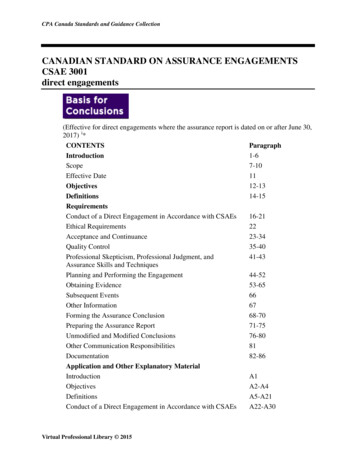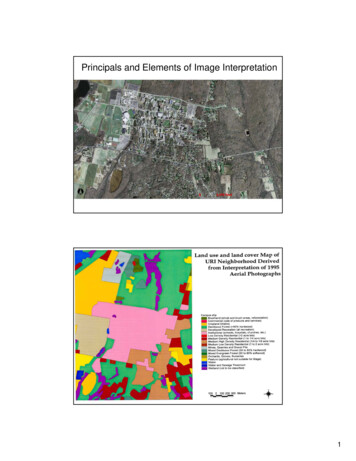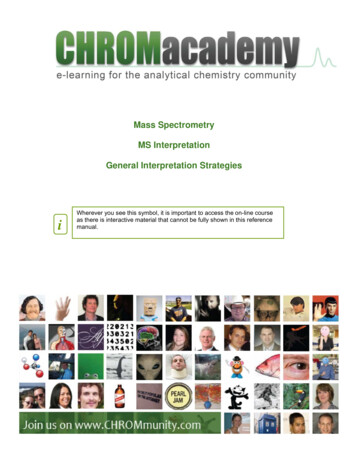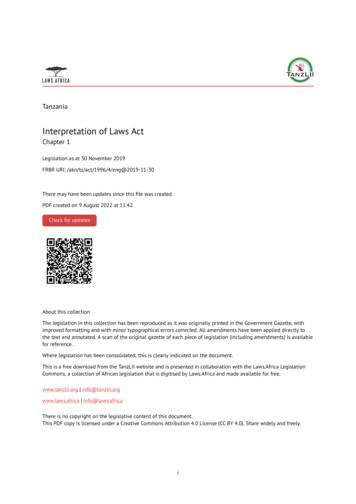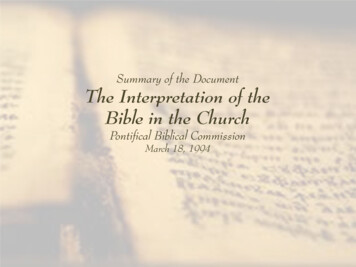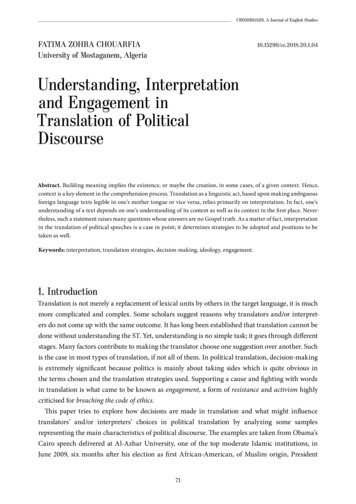
Transcription
CROSSROADS. A Journal of English StudiesFATIMA ZOHRA CHOUARFIAUniversity of Mostaganem, Algeria10.15290/cr.2018.20.1.04Understanding, Interpretationand Engagement inTranslation of PoliticalDiscourseAbstract. Building meaning implies the existence, or maybe the creation, in some cases, of a given context. Hence,context is a key element in the comprehension process. Translation as a linguistic act, based upon making ambiguousforeign language texts legible in one’s mother tongue or vice versa, relies primarily on interpretation. In fact, one’sunderstanding of a text depends on one’s understanding of its content as well as its context in the first place. Nevertheless, such a statement raises many questions whose answers are no Gospel truth. As a matter of fact, interpretationin the translation of political speeches is a case in point; it determines strategies to be adopted and positions to betaken as well.Keywords: interpretation, translation strategies, decision-making, ideology, engagement.1. IntroductionTranslation is not merely a replacement of lexical units by others in the target language, it is muchmore complicated and complex. Some scholars suggest reasons why translators and/or interpreters do not come up with the same outcome. It has long been established that translation cannot bedone without understanding the ST. Yet, understanding is no simple task; it goes through differentstages. Many factors contribute to making the translator choose one suggestion over another. Suchis the case in most types of translation, if not all of them. In political translation, decision-makingis extremely significant because politics is mainly about taking sides which is quite obvious inthe terms chosen and the translation strategies used. Supporting a cause and fighting with wordsin translation is what came to be known as engagement, a form of resistance and activism highlycriticised for breaching the code of ethics.This paper tries to explore how decisions are made in translation and what might influencetranslators’ and/or interpreters’ choices in political translation by analyzing some samplesrepresenting the main characteristics of political discourse. The examples are taken from Obama’sCairo speech delivered at Al-Azhar University, one of the top moderate Islamic institutions, inJune 2009, six months after his election as first African-American, of Muslim origin, President71
CROSSROADS. A Journal of English Studiesof the United States of America. His election campaign had « Change » as a slogan, change inperceptions and policies as well. So, when elected, he decided to address the Muslim World ina different way; he made sure to tackle all issues, controversial or not, without hurting his targetaudience, for it was meant to be « A New Beginning » as he labelled his speech. The task soundedlike an uphill battle, but he managed to handle it. The official website of the White House offeredtranslations into 15 languages and made them available on the same day, ready to be read and/ordownloaded. Many TV channels, including Arabic language ones, aired the speech interpretedinto national languages. Our main focus will be on the Russia Today interpretation of the speech.2. Understanding meaningMeaning is built in a different order depending on the role one is supposed to play in the communication process. To the sender, it is prior to expression, i.e. one thinks first of the point one wantsto make and then chooses the right words to convey the message, whereas the receiver grasps themeaning after reading or hearing some discourse. Yet, words alone are just one way to make one’smessage shine through (Seleskovitch 1976); gestures, posture, tone, etc. are other tools that servethe same purpose.Meaning is what an author is deliberately willing to say. It has nothing to do with the reasonsand consequences of what is being said, and should be distinguished from one’s motives and intentions (Lederer & Seleskovitch 2001: 269).Dan Sperber postulates that understanding goes through two stages; the first one consists inunderstanding the language of the text in question, while the second one is deducing the meaningwith the help of some extra-linguistic knowledge (cited in Lederer 1994: 25). However, meaning isgrasped in one step only; at the discourse level. Words have different meanings according to wherethey are placed in the sentence, and how they are contextualized.In the 1960s, Marianne Lederer and Danica Seleskovitch, inspired by their work as conferenceinterpreters, put forward an interpretive approach to translation, also known as the theory ofsense, after realizing there are more similarities between interpreting and translation thandifferences. Lederer argues that translating consists in understanding a text and then reformulatingit in another language (ibid:13). Understanding a text brings together linguistic competence andencyclopedic knowledge.It is generally accepted that a good translation is the one that has the same meaning as theoriginal. Catford assumes that meaning is « a property of a language. An SL text has an SL meaning, and a TL text has a TL meaning » (Catford 1965: 35.) This suggests that understanding andreactions are not similar as the audience in both languages-cultures have different backrgounds,world views, ideologies, beliefs and logic; what might sound quite normal and acceptabe in oneculture, could be perceived otherwise in another cultural milieu. Besides, the TT does not necessarily have the same objectives as the ST. So, the form and content of each text vary according tothe function it aims to fulfill. Hence, meaning might change from one language to another.72
CROSSROADS. A Journal of English Studies3. Ideology and position of the translator3.1. Ideological turn in translationThe “cultural turn” in translation is one of the main reasons translation studies started gettinginterested in ideology, for translation goes beyond the text to involve culture and politics (Mª RojoLópez & Ramos Caro 2014: 251). This approach deals with issues such as the different situations ofliterature, ideological implications of translation and power relations between cultures.Ideologies represent who we are, what our values and beliefs are, and what our relationships arewith our friends and foes (Van Dijk 1998: 69). According to Fawcett, beliefs play a major role inproducing a particular effect in translation (Fawcett 1998: 106-7). This can be seen in cases whereindividuals and/or institutions avoid some words and use others instead, or when the passivevoice is privileged in order to hide some aspect of power (Schäffner 2003: 23).This approach holds the recipient responsible for understanding the text and interpreting it.The aim is to highlight the ideological importance of translation so that it is regarded as a meansof ideological resistance.3.2 Engagement in translationNeutrality in translation is a delusion (Guidère 2008: 98) and precision is nothing but an illusion.If we accept that the translator is compelled to take the target culture into account as he has tocreate the same effect so that the receiver feels no strangeness in the translated text, it follows thatthe strategies chosen, the decisions made and the text’s parts that are emphasized demonstrate towhat extent a translation might be biased, and can be used as proof of some kind of engagementin translation, whether implicit or explicit (Tymoczko 2000). As a matter of fact, the translator isinterested in politics, takes sides, has political positions and their own views on what’s right andwrong, and often forgets any code of ethics or commission (Baker 2009: 24).The word engage has several meanings, one of which is « to enter into combat with (an enemy) gage). Such a meaning can apply to translation, fortranslators do experience some sort of ideological conflict (Tymoczko 2000). Speaking of Engagement in translation entails dealing with activism as well, since some translations « rouse, inspire,witness, mobilize, and incite to rebellion. » (Tymoczko 2007 : 213). « Engaged translators [ ] havepolitical agendas and use translation as one means to achieve those agendas. » (ibid) Opting forforeignization as a translation strategy in order to resist the translator’s invisibility (Venuti 1995)or enrich the language introducing loanwords and syntactic structures is one way to be an engaged translator. Nevertheless, the task of the translator, according to Archibald, is to maintainthe national identity by monitoring the quality of the common language and protecting it fromneologisms and the like (Archibald 2016).In order for a translation to be a means of political engagement, the translator must have a setof goals and values that should be respected when choosing texts, and a will to manipulate and73
CROSSROADS. A Journal of English Studiesadapt them to political agendas. Moreover, creativity is needed in diversifying translation strategies (Tymoczko 2000).According to Chesterman, “the political engagement of the translator . . . lies outside the realmof professional ethics” (cited in Tymoczko 2007: 320) while Mona Baker argues that the politicalactivism of some translators does not make them any less professional than their peers who arenot engaged (Baker 2009).4. Interpretation and translationAccording to Walter Benjamin, translation is some sort of afterlife to the source text as not allworks are translated at the time the original is published (Benjamin 2000: 16). However, whileworks get to live longer, authors either die (Barthes 1977) or no longer have any authority norpower whatsoever over their own writings, for there is no real sense of a text; once published, it islike a device that anyone can use as they please. It is not sure that the creator uses it better thanany other person (Valéry 1936).Ideas can be expressed in multiple ways; words may change but the gist remains the same. Thiscould be explained by the fact that humans think differently because of where and how they werebrought up, which has an impact on the ideologies they adopt as well as the purposes they intendto achieve through text and talk. Hence, the consequences of their utterances depend on how theysay what they say and how the receiver may understand their statement. Interpretation comesright after trying to understand as a reaction to an action. In other words, interpretation is theapplication of understanding; what one understands and how one understands it require somefoundation to base on, a starting point. Yet, Seleskovitch insists on distinguishing discourse fromlanguage when translating. Translators as well as interpreters deal with discourse, i.e. languageput into context. A simultaneous interpreter, for instance, would not try to figure out the meaningof every single word separately, for what matters to them is the sentence as a whole and the ideasconveyed through it (Seleskovitch & Lederer op.cit: 104-5).The next step after understanding isinterpretation, but since several possibilities might fit, the translator and/or interpreter resortsto negotiation (Eco 2006) and proceeds with an elimination method in order to finally make uptheir mind on which word seems to be adequate.One has to admit that not all potential interpretations are correct; there are as manyinterpretations as receivers. It entails that not all suggestions can be trusted as true and relevant. Ifa text is found in a bottle without any hint indicating its author’s name or the period of time it waswritten in, will it be interpreted the same way when both are known? (Eco 1992: 134). Eco arguesthat a distinction needs to be made between the intention of the author and the intention of thetext. The text may reveal things the author did not even think of. So, if the author is still alive, theymight be asked if they really intended to mean what was understood. The answer should not beused to confirm interpretation of the text but to show unconformity between the intention of theauthor and the intention of the text (ibid: 138). In other words, interpretations do not necessarily74
CROSSROADS. A Journal of English Studiesuncover the truth behind text and talk. Authors may have had other intentions rather than theones perceived as such.5. Some political discourse characteristics and translation strategiesLanguage is a key element in politics; it is the tool politicians use to shape the world the way theysee fit. Chilton argues that even a declaration of war is a linguistic act in the first place (Chilton1997: 175). Thus, if one were to define political discourse, the easiest and simplest definition wouldbe that it is a discourse about politics; i.e. a discourse that deals with political issues (Van Dijk1997). Now, what is politics? One may wonder. It is « who gets what, when and how » (Lasswell1936). So, a political discourse may be « a parliamentary debate, a propaganda leaflet, a campaignspeech or a revolutionary slogan », etc. (Van Dijk 1997: 18).As any discourse related to a specific field, political discourse has characteristics of its own,maybe not unique nor specific to it in particular, but altogether they make it special. In what follows, some characteristics along with examples and the strategies used to translate them will beexamined.5.1 EuphemismEuphemism can be defined as « a mild or indirect word or expression substituted for one considered to be too harsh or blunt when referring to something unpleasant or embarrassing. » emism). Longman English dictionary offers anotherdefinition where politeness is a keyword; « a polite word or expression that you use instead of amore direct one to avoid shocking or upsetting someone » . In fact, generally speaking, saving one’s face is the main reason one has recourseto such a linguistic tool (Goffman 1959).Euphemisms are either positive or negative. The positive ones are intended to inflate and magnify the euphemized items so they seem more important than they really are. Negative euphemisms, on the other hand, deflate, diminish and eradicate from the language every topic peopledo not like dealing with directly (Rawson 1981: 1).Euphemisms are frequently used in political texts to conceal the realities and make atrocities lookless dramatic. They are « the politician’s most useful weapon for telling lies » (Newmark 1991: 158).Euphemisms can be composed of one word only or a group of words. Manar Abdulhafeeth Abdalla studied euphemisms and compared them to fixed expressions. She came to the conclusionthat there are some common traits between them and stated some difficulties a translator and/oran interpreter may come across.It is hard to: identify whether it is a euphemism or not in the SL ; understand the form of the euphemism in the SL ; understand the cultural load of the euphemism in the SL ; find an equivalent in the TL.75
CROSSROADS. A Journal of English Studies determine « what to do when the ‘deceptive’ content of the euphemism in the ST, if notrevealed in the TT, would have an adverse effect on the members of the TL community. »(Abdulhafeeth Abdalla 2009: 40).Since euphemisms are similar to fixed expressions, then the same strategies can be used to render them in the target language: Using a euphemism of similar meaning and form ; using a euphemism of similar meaning but dissimilar form ; translation by paraphrase ; translation by omission (Baker 1992 :72-77.): ST issue: ‘ The thatfirst issuethat weto confrontis violentextremismininallall ofe.g. 1 : ST : ‘ e.g.The 1firstwe havetohaveconfrontis violentextremismofitsitsforms.’forms.’Obama tried toObamaavoid thetermsthe« terrorand «« terrorism», oftenused whenreferringto referring totriedusualto avoidusual »termsterror » and« terrorism», oftenused whenacts of violence,employedthe euphemism« extremism» instead.However,renderingacts ofandviolence,and employedthe euphemism« extremism» instead.However,rendering «extremwaswasout offor the forRussiaArabicinterpreter« extremismism»» asas " "تطرف ininArabicArabicoutquestionof questiontheTodayRussiaTodayArabic (hence RT Int)(The firstissueweissuemustconfrontisasex terrorismand violencein all areas.)(Thefirstmust confrontis ex terrorismand violencein all ter (henceRT Int) whoinerpretedthesentence as follows :The RT TheInt hesitatedand was andaboutto abouttranslate« extremism» as " "تطرف first, itsArabicRT Int hesitatedwasto translate« extremism» as at" "تطرف at first,its ArabicTT : .‘ اإلر هاب والعنف في كل المناطق الموجودة . ’أول مسألة التي يجب علينا مواجهتها هي التط equivalent,but then butsteppedbackandbackchose« اإلرهاب instead,» Arabicfor« terrorism». This ». Thisequivalent,thensteppedandchoseand«» اإلرهاب instead,Arabicfor « terrorism(The firstissuewewemustconfrontis ex terrorismviolencein all areas.)(Thefirstissuemustconfrontisex terrorismandviolenceinallareas.)(The first issue we must confront is ex terrorism and violence in all areas.)choice ischoicenot justdecisionbut a positiontaken as takenwell. TheRT TheInt chosenotchoseto deceiveis anotjust a decisionbut a positionas well.RT Intnot to hisdeceive histarget audiencebyusingwhichhidethe hidetruth,decidedtocall ataatspadea dtruth,decidedtofirst,call mism»asas" "تطرف boutabouttotototranslate" "تطرف isspade.equivalent,Sucha dbackand«« اإلرهاب wasbackdeterminedby multiplefactors.Firstly,interpretingan Americanequivalent,butthensteppedbackandchose اإلرهاب senottodeceivehistargetspeech fora RussianTVsomeeffectsonthe Theend;productone justhastochoiceisforbuta apositiontakenasaswell.RTnotspeecha justRussianTV mustchannelmusthavesomeeffectson producttheend; toonejust todeceivedeceivehisaudience by using euphemisms which hide the truth, and decided to call a spade a spade. Suchtake a lookbackat backhistorybetweenthe two thecountriesto ichandtotocalla anddecideddecidedcallspadea strategy was determined by multiple factors. Firstly, interpreting an American speech for ainterpretermighthavehisownwaspoliticalviews andagenda.thetargetaudienceis thespade.Sucha tinganAmericaninterpretermighthavehispoliticaland Thirdly,agenda.Thirdly,thetarget audienceis ly,Firstly,AmericanRussianTVchannelmust havesome effectsbyonmultiplethe end product;one justinterpretinghas to take aanlookback atmost fectsthat’swhyrespectingtheir; justhasmostimportantin wayofspeechfora pretermighthavehisthinkingis politicalthetoppriority.takea stand.thethinkingis iveact, hisandthatispoliticalwhy respectingtheirwayThirdly,ofthinkingistargetthe hyrespectingrespectingtheirtheirwaywayofofe.g. 2 : ST: ‘2 Resistancethrough violenceand killingwrongis( ).’ ( ). ’e.g.: ST:the‘ ppriority.priority.e.g. 2 :ST :‘ Resistance through violence and killing is wrong ( ). ’TT : ‘.).( والقتل والقتلالعنف العنفخالل والمقاومة من TT خاطئة : ‘.).( خاطئة ’والمقاومة ’من خالل It is generallyin the politicalandmediamainstream,the( isthatwrong2:accepted,:STST: :‘ ‘ResistanceResistanceviolenceandkillingwrong( ).’ atPalestinian movementmovementfightingtheIsraelioccupationis a terroristorganization.However,Obama nterroristorganization.However,Obamaswamtheagainst thefightingthetheIsraeliis isa aterroristorganization.However,swamagainsttheTTTT: :‘.).(‘.).( خاطئة والقتلخاطئة العنفوالقتل خاللالعنف والمقاومةمنمنخالل ’ ’والمقاومة currentcurrentand usedtheusedtermresistanceinstead,a termresistanceinstead,a decisionthat broughthimmuchcriticism.andandusedthe thetermresistanceinstead,a edrenderedbyinitsitsArabicequivalentbut withaathedifferentagenda,probably.The euphemismwasbyArabic" "المقاومة nstream,thatPalestinianmovementeuphemismwas renderedby itsequivalentArabicequivalent" "المقاومة butwitha udiencein orderto turnthe thepageandthestarta thenewprobably.Obamahadto makesurenottooffendhisaudienceinHowever,orderto orderturnpageandfightingtheIsraelioccupationa admakesurenotoffendhisaudienceinto ristorganization.However,Obamaswamagainstthestart a newchapterU.S.therelationswith the nstead,a adecisionthatbroughthimcriticism.starta newchapterin termU.S.relationsthe ysuch a controversialissuecouldhavecausedunnecessaryrage " "المقاومة quivalentbutagenda,sucha controversialissuecouldcausedrageandtension,or someat bicequivalent" "المقاومة t Obamaavoid.Nevertheless,the ntothepageanddiscomfortthat triedObamatriedavoid.Nevertheless,theRT orderordertoturnturnouttheofpageand
CROSSROADS. A Journal of English Studieschapter in U.S. relations with the Islamic world. In other words, bringing about such a controversial issue could have caused unnecessary rage and tension, or at least some discomfort that Obamatried to avoid. Nevertheless, the RT Int used the equivalent out of engagement to show support tothe Palestinian cause.5.2 RepetitionRepetition is studied under lexical cohesion and is divided into reiteration and collocation.Reiteration « means either repeating an item in a large part of the discussion by direct repetitionor reasserting its meaning by developing lexical relation » (Abu Assi 2011: 21). According to Baker,items can be repeated or replaced by synonyms, near-synonyms, super ordinates or generalwords (cited in ibid.)Collocation, on the other hand, is made up of two words or more that always occur together(Gazala, cited in ibid.). There is also another type of repetition called parallelism, which refers to« a series of two or more grammatical elements of the same type joined by and (or sometimes byor) » (Beason and Lester 2009: 298).Repetition has many functions; it can be used : to emphasize; to create an emotional effect; to be questionable; to express annoyance; to persuade; to express surprise; to give instructions; as a filler (Rabab’ah & Abuserleek 2012 : 452-55).Repetition can be rendered in multiple ways: literal translation; translation by synonymy; translation by hyponymy; translation by homophony; translation by metaphor; ellipsis (Jawad 2009 :759-61); omission; pronominalisation (the use of a pronoun instead of a lexical item); paraphrase (Najjar 2014 :31-33).e.g. 3 : ST : ‘ America’s strong bonds with Israel are well known. This bond is unbreakable.’TT : ‘. ’ اﻟﺘﻮازن اﻷﻣﺮﯾﻜﻲ ﻣﻊ إﺳﺮاﺋﯿﻞ واﻟﻌﻼﻗﺔ اﻟﺘﻲ ﺗﺮﺑﻂ أﻣﯿﺮﻛﺎ ﻣﻊ إﺳﺮاﺋﯿﻞ (The American balance with Israel and the relationship between America and Israel.)77
CROSSROADS. A Journal of English StudiesRepetition is used in both ST and TT. Yet, the elements repeated are not the same; the RT Intbond. This could be explained by the fact that Obama wanstressed the countries in question (America and Israel), whereas Obama insisted on the bond. Thisrelations,betweenthe USrelations,and Israel,betweenthat cancould be explained by the fact that Obama wanted toemphasizethe strongthenever be brokenon the otherhand,is a delicateUS and Israel, that can never be broken no matter RTwhatInt,happens.The RTInt,knowson theit otherhand, issue for Mulanguagesand origins.So, andinsteadof keepingknows it is a delicate issue for Muslims worldwidetheirregardlessof theirlanguagesorigins.So, the originatwothecountriesthat remindof the Arab-Israeli coninstead of keeping the original emphasis, he chose tothestresstwo countriesthat Muslimsremind Muslimsof the Arab-Israeli conflict. Furthermore, the RT Intinterpretedinterpreted««bonds»as " ( "التوازن balance) at thethe beginning of tbonds » asbeginning of the unit in order to demonstrate how interdependentboth bothcountriesare onother.how interdependentcountriesareeachon eachother.5.3 MetaphorA metaphor is a figure of speech widely used in political texts as a persuasion technique. In order5.3. METAPHORto better understand this concept, one has to check out its etymology. « The word metaphor comesmetaphora figure “over”of speechused“toin political textsfrom the Greek word metaphora which is derived Afrommeta,ismeaningandwidelypherein,carry”, which means to carry or to transfer something.» (Shuttleworth& Abdullah2013:one610)order tobetter understandthis concept,has to check oSo, metaphor consists in transferring some concept’smeaningcomesto anotherand bywordso doing,itmetaphorfrom one,the Greekmetaphorawhich ischanges the characteristics of the word in question. “over” and pherein, “to carry”, which means to carry or to transAs far as translation of metaphor is concerned, severalstrategiesbe So,adopted.In hisPh.D. in transferrin& Abdullah2013 can: 610)metaphorconsiststhesis, « Metaphor in Translation: A Multilingual Investigation into Language Use at the Frontiersanother one, and by so doing, it changes the characteristics of thof Scientific Knowledge », Mark Shuttleworth cites some procedures :far ashastranslationof metaphoris concerned,several s «Reproducing the same image in TL, ‘provided theAsimagecomparablefrequencyandcurrency in the appropriate register’Ph.D thesis, « Metaphor in Translation: A Multilingual Investig Replacing the image in SL ‘with a standard TL Frontiersimage whichdoes notKnowledgeclash with theTL culture’of Scientific», MarkShuttleworth cites so Translating the metaphor by a simile, ‘retaining the image’« Reproducing the same image in TL, ‘provided the ima ‘Translation of metaphor (or simile) by simile plus sense’and currency in the appropriate register’ Conversion of the metaphor to senseFurtherin his thesis, ofShuttleworthcomes to the conclusionthat theretheareimagesomeinstrategies ReplacingSL ‘with a standard TL image Modificationthe metaphorwhich aremore than others : usedDeletionTL culture’ Using the same metaphor combined with the sense.»(cited in Shuttleworth84) ‘retaining the imag Translatingthe metaphor2013:by a simile, RetentionFurther in his thesis, Shuttleworth comes to the conclusionthat thereofaresome strategies ‘Translationmetaphor(or simile)whichby simile plus sense areModificationused more than others: Conversion of the metaphor to sense RemovalRetention Modification of the metaphorModification Omission Deletion Removal Addition (ibid : 126-132). Using the same metaphor combined with the sense Omission2013 :84) Addition (ibid: 126-132).e.g.4 : ST : ‘We were born out of revolution ( ).’e.g.4 : ST : ‘We were born out of revolution( ).’TT : ‘.( ) ( ’وكانت لدينا ثورة and(andwewehadhada revolution)a revolution)The RT Int chose to remove the metaphor. By so doing, he slightly changed the meaning. One78can interpret this as a will to diminish the greatness and importance the speaker was trying togive to the fact by poetically highlighting the event. Opting for such a strategy is another way10
CROSSROADS. A Journal of English StudiesThe RT Int chose to remove the metaphor. By so doing, he slightly changed the meaning. Onecan interpret this as a will to diminish the greatness and importance the speaker was trying togive to the fact by poetically highlighting the event. Opting for such a strategy is another way ofactivism and engagement in translation, for this unit was taken from a paragraph
voice is privileged in order to hide some aspect of power (Schäffner 2003: 23). This approach holds the recipient responsible for understanding the text and interpreting it. The aim is to highlight the ideological importance of translation so that it is regarded as a means of ideological resistance. 3.2 Engagement in translation


